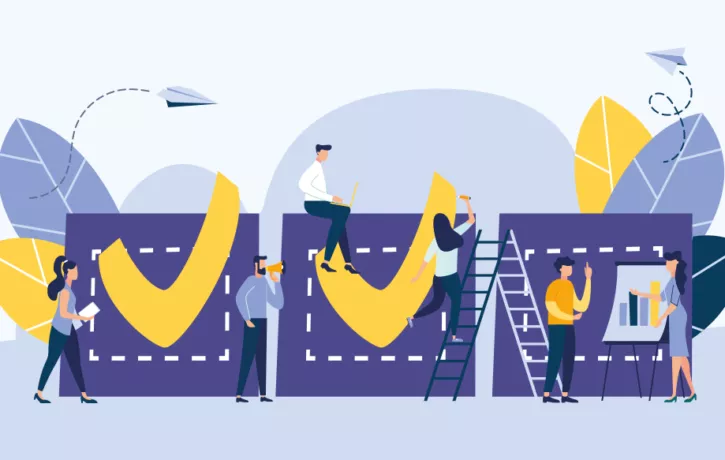We all know the importance of effective employee onboarding.
With effective onboarding, your new employees will become meaningful contributors faster and start off with high engagement.
The success of your onboarding process has broader effects as well, impacting key metrics such as employee productivity, loyalty, and satisfaction. That’s why an employee onboarding template is your ticket to new hire success.
Dive Deeper: How Poor Employee Onboarding Can Become Your New Hire’s Worst Nightmare
What the research says about onboarding
While the importance of onboarding is understood among HR professionals, there’s a wide gap between knowledge and application, despite strong evidence in favor of structured onboarding programs.
According to research compiled by O.C. Tanner:
- 69% of employees are more likely to stay with a company for at least 3 years if they had a great onboarding experience.
- Only 1 in 4 employees worldwide feel connected to their company’s mission
- 50% of employees don’t find meaning in their current job role
That should be enough to make the case for structured onboarding, but the picture becomes even starker when you 
- Even an $8-per-hour employee can cost $3,500 or more in turnover costs, one would think that the onboarding process would take more precedence in modern organizations
- Companies spent an average of $986 and 46.7 hours per learner in 2018
- Employees take an average of 5 months to reach full productivity
Of course, these statistics are just the tip of the iceberg.
When you multiply these costs by the number of new employees you hire each year, the criticalness of structured onboarding is obvious.
The cultural implications of poor onboarding
Poor onboarding costs an organization in more ways than one.
Employees who aren’t integrated properly into the workplace suffer a range of problems, such as:
- Lack of motivation and morale
- Sub-par productivity
- Disengagement from the job, their coworkers, and the company
- Higher likelihood of turnover
However, problems don’t stop there.
They also affect the new hire’s coworkers, the department, and the organizational culture. If your onboarding system is ill-equipped to get new hires up to speed, other team members will need to pick up the slack, which can create a stressful environment for everyone.
But things don’t need to be that way. With the right approach to onboarding, you can create a different scenario.
One where:
- New employees know exactly what to expect from day one
- They receive specific, timely training that’s relevant and actionable
- They feel motivated, happy, and satisfied with their new job
There’s no such thing as a magic bullet, but with the right guidance, you can set your employee onboarding on the right track.
The 5-Minute Employee Onboarding Template
An employee onboarding template is a perfect go-to solution for busy HR professionals.
Here’s why:
- It’s fast and easy
- It’s flexible, which means it can be adapted to any situation or employee
- It saves you time by putting everything in one place
In less than five minutes from now, you’ll learn the foundation for building an effective and customizable employee onboarding template.
Layout: Time and Activity
Start by writing everything out. At the top of the document, write the key new hire information — such as the employee name, employee information, manager, department, and position — as well as relevant onboarding time periods.
To start, create a set of columns for:
- The activity or task
- Who is responsible
- Whether it was completed or not
- The contact person
- Time and location
- Other notes
Then, create 3-5 sections of rows.
Label these sections with the stage of your process.
Stage 1: Pre-Hire
For HR and the new hire’s department, onboarding tasks begin before the employee arrives.
During the pre-hire stage, create a list of common tasks that must be undertaken for each employee, such as:
- Ordering office equipment
- Scheduling on-site training sessions with staff
- Sending a welcome email and information packet
It is useful to leave blank spaces for any other items that may be specific for that person or department.
Instantly simplify employee onboarding with the Digital Adoption Platform (DAP). Request a demo.
Stage 2: First Week
The first week will include all of the employee’s initial activities, such as:
- Office tours
- Attending orientation meetings
- Filling out new-hire documentation, benefits information, etc.
- Meetings with managers
- Clarifying the role, setting goals, and getting started with introductory work
And any other company- or employee-specific activities.
Stage 3: The First Month
Any activities that must be completed within 30 days can be included here.
For instance:
- Functional training sessions
- Software onboarding
- Cultural integration activities
- One-on-one meetings with manager
- Check-ins with HR
Stage 4+
Beyond this, you can include other time periods that suit you.
The most common would be just one last stage, including tasks that must be completed within 90 days.
As you can see, this 5-minute template is very straightforward and not difficult to implement. It is not comprehensive but provides the framework to guide onboarding with room for personalization and additions as needed.
WalkMe’s Digital Adoption Platform (DAP) transforms the user experience in today’s overwhelming digital world. Using artificial intelligence, engagement, guidance, and automation, WalkMe’s transparent overlay assists users to complete tasks easily within any enterprise software, mobile application or website. Discover how a DAP can revolutionize your business.



